译林版(2020) 选修第一册 Unit 1 Food matters Reading课件(16张)
文档属性
| 名称 | 译林版(2020) 选修第一册 Unit 1 Food matters Reading课件(16张) | 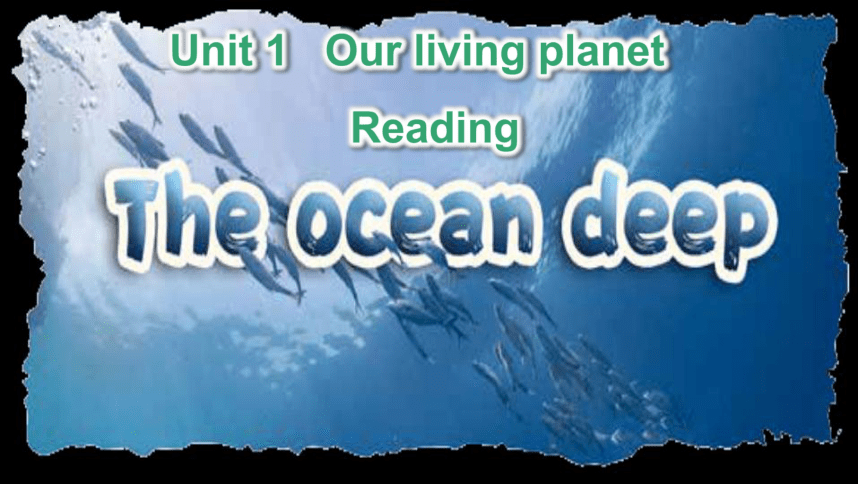 | |
| 格式 | pptx | ||
| 文件大小 | 2.6MB | ||
| 资源类型 | 教案 | ||
| 版本资源 | 牛津译林版(2019) | ||
| 科目 | 英语 | ||
| 更新时间 | 2022-04-09 23:35:04 | ||
图片预览

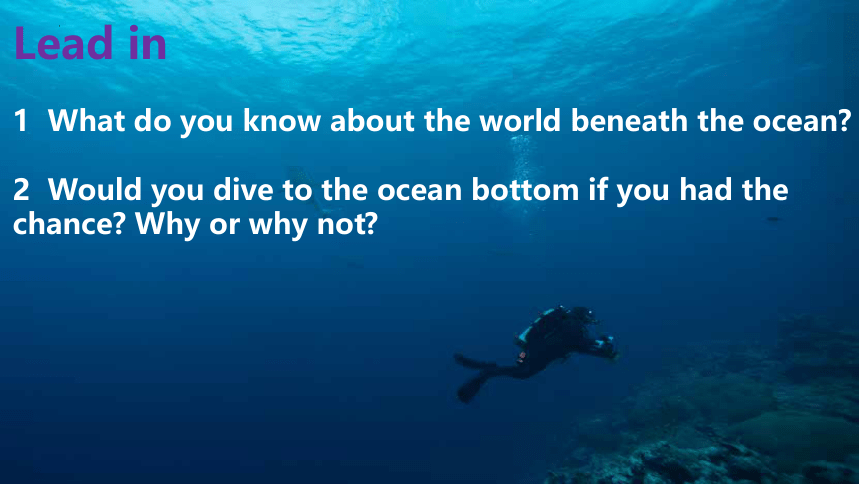
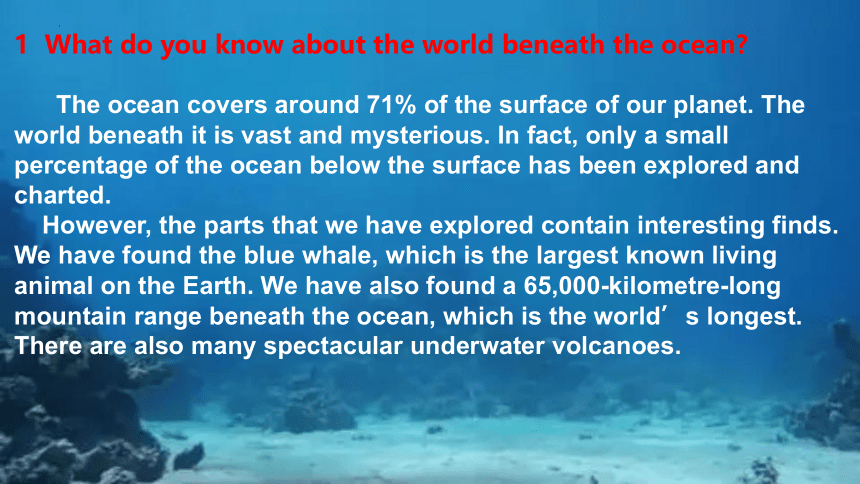
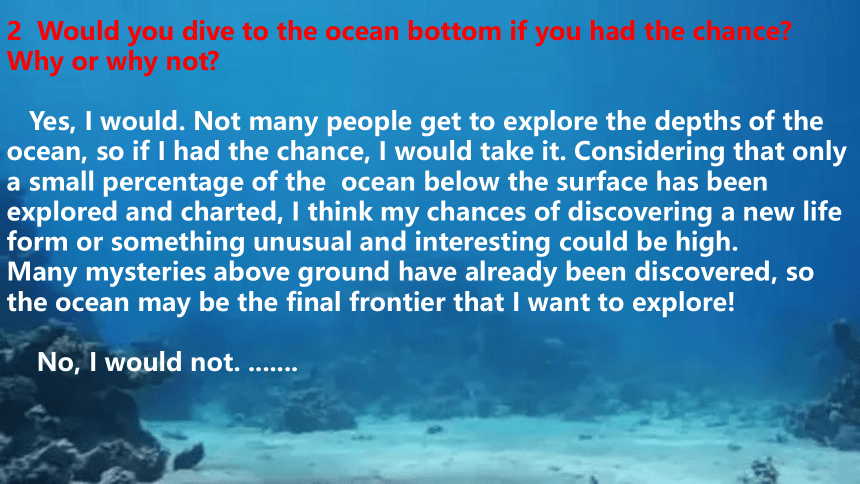
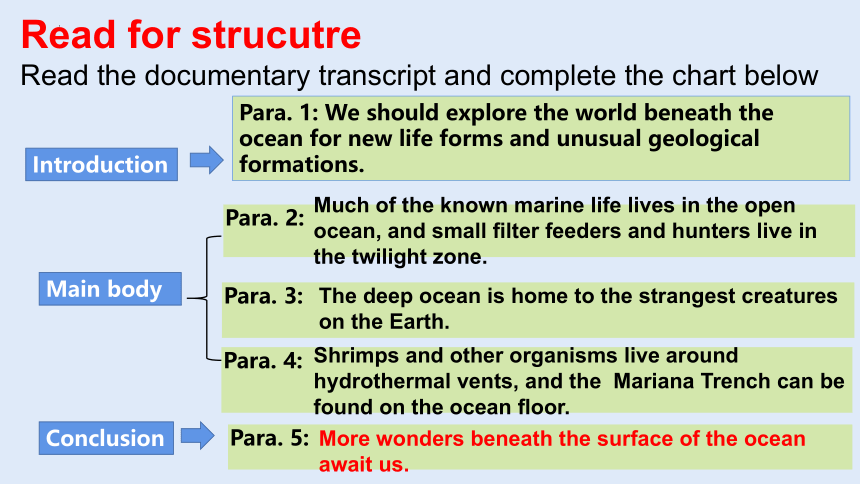

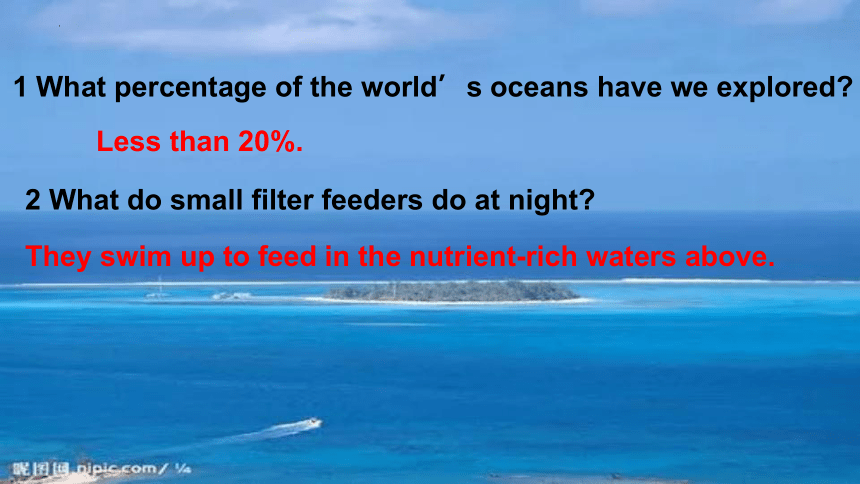
文档简介
(共16张PPT)
Unit 1 Our living planet
Reading
Lead in
1 What do you know about the world beneath the ocean
2 Would you dive to the ocean bottom if you had the chance Why or why not
1 What do you know about the world beneath the ocean
The ocean covers around 71% of the surface of our planet. The
world beneath it is vast and mysterious. In fact, only a small
percentage of the ocean below the surface has been explored and
charted.
However, the parts that we have explored contain interesting finds.
We have found the blue whale, which is the largest known living
animal on the Earth. We have also found a 65,000-kilometre-long
mountain range beneath the ocean, which is the world’s longest.
There are also many spectacular underwater volcanoes.
2 Would you dive to the ocean bottom if you had the chance Why or why not
Yes, I would. Not many people get to explore the depths of the ocean, so if I had the chance, I would take it. Considering that only a small percentage of the ocean below the surface has been explored and charted, I think my chances of discovering a new life form or something unusual and interesting could be high.
Many mysteries above ground have already been discovered, so the ocean may be the final frontier that I want to explore!
No, I would not. .......
Read for strucutre
Read the documentary transcript and complete the chart below
Para. 3:
Para. 2:
Para. 4:
Para. 5:
Para. 1: We should explore the world beneath the ocean for new life forms and unusual geological formations.
Introduction
Main body
Conclusion
Much of the known marine life lives in the open ocean, and small filter feeders and hunters live in the twilight zone.
The deep ocean is home to the strangest creatures on the Earth.
Shrimps and other organisms live around
hydrothermal vents, and the Mariana Trench can be found on the ocean floor.
More wonders beneath the surface of the ocean await us.
Read for details
Read the transcript again and finish A2 on page 4.
1 What percentage of the world’s oceans have we explored
2 What do small filter feeders do at night
3 How do blind creatures in the deep ocean manage to survive
4 What has changed scientific opinion about the chances of there being life elsewhere in the universe
1 What percentage of the world’s oceans have we explored
2 What do small filter feeders do at night
They swim up to feed in the nutrient-rich waters above.
Less than 20%.
3 How do blind creatures in the deep ocean manage to survive
4 What has changed scientific opinion about the chances of there being life elsewhere in the universe
The knowledge that life can exist in the extreme conditions on the ocean floor.
They depend on other senses such as smell and their
ability to detect slight changes in water pressure to obtain
food and avoid being caught.
Discussion
In pairs, discuss the following questions.
1 Why does the author mention Mount
Qomolangma when describing the Challenger Deep
2 At the end of the first paragraph, a question is asked, and at the end of the last paragraph,another question is asked. What is the author’s purpose of writing in this way
3 Which of the three zones (the open ocean, the twilight zone and the deep ocean) attracts you most Why
The author wants to highlight how deep the Challenger Deep is. By comparing it to the highest mountain in the world, Mount Qomolangma, she helps the reader visualize its depth.
1 Why does the author mention Mount Qomolangma when
describing the Challenger Deep
2 At the end of the first paragraph, a question is asked, and at
the end of the last paragraph,another question is asked. What
is the author’s purpose of writing in this way
The first paragraph aims to attract the reader to the topic of deep-sea exploration by asking the question: “Then why don’t we dive to the bottom of a really deep ocean and take a long, close look beneath the waves ” The last paragraph serves as a conclusion. After describing the ocean deep, the author gives an ending to this documentary transcript. By asking the question: “... who knows what wonders still await us in the future ”, the author reminds the reader that the exploration of the unknown part of the ocean will never come to an end.
3 Which of the three zones (the open ocean, the twilight zone
and the deep ocean) attracts you most Why
In my opinion, the deep ocean is full of magic and mystery, which attracts me most. I thought that all life on the Earth obtained its energy from the sun. Now I know that life forms can obtain nutrients and energy from thermal sources. Interestingly, on the ocean floor, many strange geological formations can be found, such as canyons and slopes. It is really amazing that the Challenger Deep, the deepest point of the
Mariana Trench, is nearly 11,000 metres below sea level.
Consolidation : Complete part B1
The world’s vast oceans, now well accepted as the Earth’s “final frontier”, (1) _________________ the hearts of scientists and explorers. While most of the Earth’s land mass has been explored and mapped, around 80% of the oceans remain to be explored and great discoveries (2) _________________ us. Therefore, many countries have spared no effort in deep-sea exploration. Leading the way is China, one of the few countries that have developed the ability to send humans to the deepest parts of our oceans.
capture/have captured
await
In June 2012, China’s first deep-sea manned submersible, Jiaolong, set a world (3) _________________ record for submersibles of its kind, by reaching a depth of 7,062 metres in the Mariana Trench in the Pacific Ocean. In 2017, China successfully tested Shenhai Yongshi, a submersible capable of reaching a depth of 4,500 metres. Later it conducted hundreds of dives in different oceans, exploring what lay deep (4) _________________ the water. With all of its core components produced (5) _________________ by China, it has paved the way for deeper and broader undersea exploration in the future.
solely
beneath
diving
The year 2020 witnessed another significant milestone in China’s (6) _________________ technology, when the deep-sea manned submersible Fendouzhe completed eight successful dives of more than 10,000 metres in the Mariana
Trench.
These breakthroughs have demonstrated China’s determination to explore the deep sea and its underwater research potential (7) _________________. Travelling down to extreme depths not only allows us to (8)______________ new insights into the ocean, but it also opens up exciting opportunities that will eventually benefit the world above.
marine
in equal measure
obtain
T_________________ us. Therefore, many countries
hnew insights into the ocean,
but it also opens up exciting opportunities that will eventually benefit the world above.
Tkank you
Unit 1 Our living planet
Reading
Lead in
1 What do you know about the world beneath the ocean
2 Would you dive to the ocean bottom if you had the chance Why or why not
1 What do you know about the world beneath the ocean
The ocean covers around 71% of the surface of our planet. The
world beneath it is vast and mysterious. In fact, only a small
percentage of the ocean below the surface has been explored and
charted.
However, the parts that we have explored contain interesting finds.
We have found the blue whale, which is the largest known living
animal on the Earth. We have also found a 65,000-kilometre-long
mountain range beneath the ocean, which is the world’s longest.
There are also many spectacular underwater volcanoes.
2 Would you dive to the ocean bottom if you had the chance Why or why not
Yes, I would. Not many people get to explore the depths of the ocean, so if I had the chance, I would take it. Considering that only a small percentage of the ocean below the surface has been explored and charted, I think my chances of discovering a new life form or something unusual and interesting could be high.
Many mysteries above ground have already been discovered, so the ocean may be the final frontier that I want to explore!
No, I would not. .......
Read for strucutre
Read the documentary transcript and complete the chart below
Para. 3:
Para. 2:
Para. 4:
Para. 5:
Para. 1: We should explore the world beneath the ocean for new life forms and unusual geological formations.
Introduction
Main body
Conclusion
Much of the known marine life lives in the open ocean, and small filter feeders and hunters live in the twilight zone.
The deep ocean is home to the strangest creatures on the Earth.
Shrimps and other organisms live around
hydrothermal vents, and the Mariana Trench can be found on the ocean floor.
More wonders beneath the surface of the ocean await us.
Read for details
Read the transcript again and finish A2 on page 4.
1 What percentage of the world’s oceans have we explored
2 What do small filter feeders do at night
3 How do blind creatures in the deep ocean manage to survive
4 What has changed scientific opinion about the chances of there being life elsewhere in the universe
1 What percentage of the world’s oceans have we explored
2 What do small filter feeders do at night
They swim up to feed in the nutrient-rich waters above.
Less than 20%.
3 How do blind creatures in the deep ocean manage to survive
4 What has changed scientific opinion about the chances of there being life elsewhere in the universe
The knowledge that life can exist in the extreme conditions on the ocean floor.
They depend on other senses such as smell and their
ability to detect slight changes in water pressure to obtain
food and avoid being caught.
Discussion
In pairs, discuss the following questions.
1 Why does the author mention Mount
Qomolangma when describing the Challenger Deep
2 At the end of the first paragraph, a question is asked, and at the end of the last paragraph,another question is asked. What is the author’s purpose of writing in this way
3 Which of the three zones (the open ocean, the twilight zone and the deep ocean) attracts you most Why
The author wants to highlight how deep the Challenger Deep is. By comparing it to the highest mountain in the world, Mount Qomolangma, she helps the reader visualize its depth.
1 Why does the author mention Mount Qomolangma when
describing the Challenger Deep
2 At the end of the first paragraph, a question is asked, and at
the end of the last paragraph,another question is asked. What
is the author’s purpose of writing in this way
The first paragraph aims to attract the reader to the topic of deep-sea exploration by asking the question: “Then why don’t we dive to the bottom of a really deep ocean and take a long, close look beneath the waves ” The last paragraph serves as a conclusion. After describing the ocean deep, the author gives an ending to this documentary transcript. By asking the question: “... who knows what wonders still await us in the future ”, the author reminds the reader that the exploration of the unknown part of the ocean will never come to an end.
3 Which of the three zones (the open ocean, the twilight zone
and the deep ocean) attracts you most Why
In my opinion, the deep ocean is full of magic and mystery, which attracts me most. I thought that all life on the Earth obtained its energy from the sun. Now I know that life forms can obtain nutrients and energy from thermal sources. Interestingly, on the ocean floor, many strange geological formations can be found, such as canyons and slopes. It is really amazing that the Challenger Deep, the deepest point of the
Mariana Trench, is nearly 11,000 metres below sea level.
Consolidation : Complete part B1
The world’s vast oceans, now well accepted as the Earth’s “final frontier”, (1) _________________ the hearts of scientists and explorers. While most of the Earth’s land mass has been explored and mapped, around 80% of the oceans remain to be explored and great discoveries (2) _________________ us. Therefore, many countries have spared no effort in deep-sea exploration. Leading the way is China, one of the few countries that have developed the ability to send humans to the deepest parts of our oceans.
capture/have captured
await
In June 2012, China’s first deep-sea manned submersible, Jiaolong, set a world (3) _________________ record for submersibles of its kind, by reaching a depth of 7,062 metres in the Mariana Trench in the Pacific Ocean. In 2017, China successfully tested Shenhai Yongshi, a submersible capable of reaching a depth of 4,500 metres. Later it conducted hundreds of dives in different oceans, exploring what lay deep (4) _________________ the water. With all of its core components produced (5) _________________ by China, it has paved the way for deeper and broader undersea exploration in the future.
solely
beneath
diving
The year 2020 witnessed another significant milestone in China’s (6) _________________ technology, when the deep-sea manned submersible Fendouzhe completed eight successful dives of more than 10,000 metres in the Mariana
Trench.
These breakthroughs have demonstrated China’s determination to explore the deep sea and its underwater research potential (7) _________________. Travelling down to extreme depths not only allows us to (8)______________ new insights into the ocean, but it also opens up exciting opportunities that will eventually benefit the world above.
marine
in equal measure
obtain
T_________________ us. Therefore, many countries
hnew insights into the ocean,
but it also opens up exciting opportunities that will eventually benefit the world above.
Tkank you
同课章节目录
- Unit 1 Food matters
- Welcome to the unit
- Reading
- Grammar and usage
- Integrated skills
- Extended reading
- Project
- Unit 2 The Universal Language
- Welcome to the unit
- Reading
- Grammar and usage
- Integrated skills
- Extended reading
- Project
- Unit 3 The art of painting
- Welcome to the unit
- Reading
- Grammar and usage
- Integrated skills
- Extended reading
- Project
- Unit 4 Exploring poetry
- Welcome to the unit
- Reading
- Grammar and usage
- Integrated skills
- Extended reading
- Project
